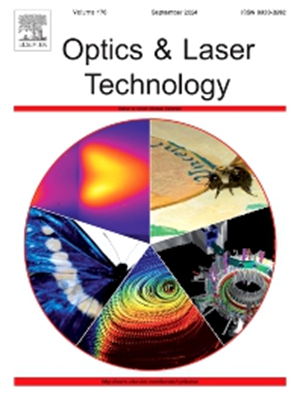缓解高PAPR和噪声问题,优化基于aco - ofdm的VLC系统的性能
IF 4.6
2区 物理与天体物理
Q1 OPTICS
引用次数: 0
摘要
可见光通信(VLC)是一种新兴的技术,可以在各种高需求的应用中补充射频(RF)通信系统。通过采用光正交频分复用(O-OFDM)技术,VLC提高了数据传输速率,最大限度地减少了码间干扰。在这些技术中,非对称截断O-OFDM (ACO-OFDM)以其较高的功率效率和优越的性能而备受关注。然而,基于ac - ofdm的VLC系统面临的一个重大挑战是高峰值平均功率比(PAPR),这迫使发光二极管(LED)工作超出其线性范围,导致信号失真、功率低效率、热应力和LED寿命缩短。此外,高PAPR增加了接收机的复杂性,限制了系统的可扩展性,需要有效的缓解策略来实现可靠的VLC部署。本研究通过引入一种结合了预编码和非线性压缩技术的混合约简策略来解决PAPR挑战。与基本的ACO-OFDM相比,该方法在不降低误码率(BER)性能的情况下实现了6.1855 dB的PAPR降低。此外,该研究通过集成接收器上的两种降噪模型来提高误码率性能。这些模型在保持相同的误码率水平的情况下,相对于标准的ACO-OFDM,系统性能提高了2.275 dB。当一起应用时,PAPR降低策略和噪声缓解模型产生的总PAPR降低6.2611 dB和BER性能提高0.76 dB。与文献中建立的方法进行了详细的比较分析,证实了所提出方法的效率和鲁棒性。该系统评估强调了其解决传统ACO-OFDM关键局限性的潜力,将其定位为下一代VLC系统的可行解决方案。本文章由计算机程序翻译,如有差异,请以英文原文为准。
Alleviating high PAPR and noise issues for optimized performance in ACO-OFDM-Based VLC systems
Visible Light Communication (VLC) is an emerging technology poised to complement radio frequency (RF) communication systems in various high-demand applications. By employing optical orthogonal frequency division multiplexing (O-OFDM) techniques, VLC enhances data transmission rates and minimizes intersymbol interference. Among these techniques, asymmetrically clipped O-OFDM (ACO-OFDM) is notable for its high power efficiency and superior performance. However, a significant challenge in ACO-OFDM-based VLC systems is the high peak-to-average power ratio (PAPR), which forces light-emitting diodes (LEDs) to operate beyond their linear range, leading to signal distortion, power inefficiency, thermal stress, and reduced LED lifespan. Additionally, high PAPR increases receiver complexity and limits system scalability, necessitating effective mitigation strategies for reliable VLC deployment. This study addresses the PAPR challenge by introducing a hybrid reduction strategy that combines precoding with nonlinear companding techniques. The proposed approach attains a PAPR reduction of 6.1855 dB compared to basic ACO-OFDM without degrading bit error rate (BER) performance. Additionally, the study enhances BER performance by integrating two noise mitigation models at the receiver. These models improve system performance by 2.275 dB relative to standard ACO-OFDM while maintaining the same BER level. When applied together, the PAPR reduction strategy and noise mitigation models yield a total PAPR diminution of 6.2611 dB and an enhancement in BER performance of 0.76 dB. A detailed comparative analysis with established methods from the literature confirms the efficiency and robustness of the proposed approach. This systematic evaluation underscores its potential to address key limitations of traditional ACO-OFDM, positioning it as a viable solution for next-generation VLC systems.
求助全文
通过发布文献求助,成功后即可免费获取论文全文。
去求助
来源期刊
CiteScore
8.50
自引率
10.00%
发文量
1060
审稿时长
3.4 months
期刊介绍:
Optics & Laser Technology aims to provide a vehicle for the publication of a broad range of high quality research and review papers in those fields of scientific and engineering research appertaining to the development and application of the technology of optics and lasers. Papers describing original work in these areas are submitted to rigorous refereeing prior to acceptance for publication.
The scope of Optics & Laser Technology encompasses, but is not restricted to, the following areas:
•development in all types of lasers
•developments in optoelectronic devices and photonics
•developments in new photonics and optical concepts
•developments in conventional optics, optical instruments and components
•techniques of optical metrology, including interferometry and optical fibre sensors
•LIDAR and other non-contact optical measurement techniques, including optical methods in heat and fluid flow
•applications of lasers to materials processing, optical NDT display (including holography) and optical communication
•research and development in the field of laser safety including studies of hazards resulting from the applications of lasers (laser safety, hazards of laser fume)
•developments in optical computing and optical information processing
•developments in new optical materials
•developments in new optical characterization methods and techniques
•developments in quantum optics
•developments in light assisted micro and nanofabrication methods and techniques
•developments in nanophotonics and biophotonics
•developments in imaging processing and systems

 求助内容:
求助内容: 应助结果提醒方式:
应助结果提醒方式:


